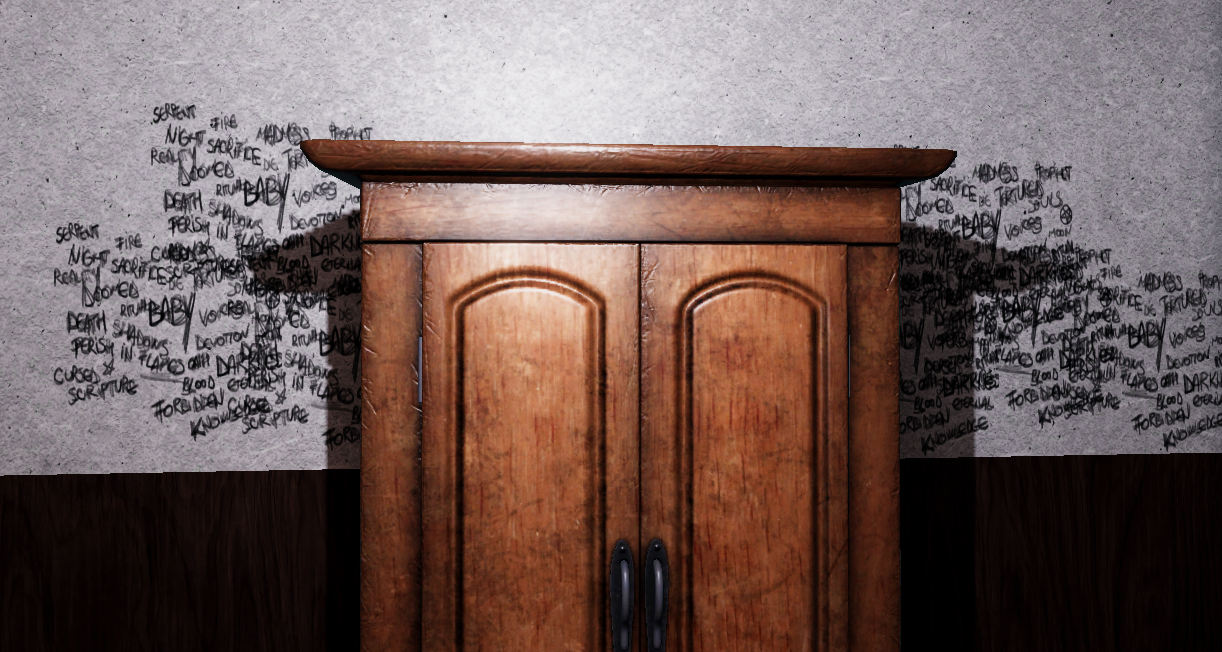Reputation Zero
One mansion. A hundred lies.
About
A team project focused on an immersive VR experience, with emphasis on player agency.
In the shoes of a detective, the player must unravel a crime that took place in a lavish mansion.
Features
Locomotion and teleportation movement systems to aid with VR accessibility.
NPC dialogue that adapts to evidence gathered and connections made.
A densely packed mansion filled with secrets to uncover and evidence to find.
A fully interactable environment and attention to detail in order to immerse the player in the world.
My Work
Programming
Created the player inventory.
Made a toggleable flashlight.
Created scripted events (such as a hidden wall that opens up when the player uses a card on a security panel).
Made numerous bug fixes (such as clipping through geometry when teleporting, held objects flinging the player etc.).
Level Design
Research on Victorian mansions and satanic cults.
Created layout of the mansion.
Made the level blockout.
Implemented scripts/scripted events.
Conducted tests on level flow.
Worked on the environment design.
Worked on the lighting and post processing effects.
Reputation Zero was a team project made as part of Galapabros.
The team consisted of me (Level Designer), Nick Risse (Team Lead, Game Designer), Nicole Wiedmaier (Programmer, Sound Artist), Desislava Stefanova (3D Artist), Guillaume Maille (VFX Artist).
On this page I will be covering my level design work for the game's main level: The Mansion. The level was designed and reiterated over a span of 5 months.
To begin, before setting out and creating a graybox for the mansion, I conducted research on various architecture designs before settling with a Victorian style after feedback sessions. I then made the floor plan of the mansion. Even though the level has gone through numerous iterations, from the start it had a ground floor and a first floor.
To help with the level flow/pacing of the mansion, I opted to have various rooms blocked off/unexplorable. This also meant that I had to find a perfect balance of explorable and unexplorable rooms, as too few rooms would make the level not feel like a mansion, and too many would make it feel overwhelming for the player. Likewise, the mansion also had to have the right balance of "filler" rooms (rooms with not much evidence/objects of interest) and "prize" rooms (rooms with important pieces of evidence) to further help with player exploration and level flow.
To put these ideas into practice, I made a graybox using Unity Probuilder. This was an efficient way of testing out if the floor plans translated well into gameplay. After a few feedback sessions I tinkered with the layout of the level (changing room sizes, swapping room positions). Before I started fleshing out the level, I recreated the main lobby concept art in-engine, to get a feel for what the environment design of the level would look like.
The level takes place at night, during a raging thunderstorm. There is a power outage due to the thunderstorm, so various places of the mansion are lit only by the moonlight pouring through the windows. I made this decision to make the level more atmospheric and spooky, but also to help with the level design. To elaborate, light sources play an important part in this level, helping guide the player to areas of interest (such as the ground floor west hallway or the dining room).
Furthermore, I tried making each wing of the mansion look unique (as to not make the player feel lost), while also making them look consistent/not out of place.
Since this was a detective game, the mansion was important to contain pieces of the mystery the player has to connect. The level would have to be sprinkled with evidence, red herrings, puzzles and anything in-between. To find the perfect position for all of these things, I conducted numerous play tests until I struck gold.
In addition to evidence that the player picks up, as well as the information they gather from interrogating suspects, I wanted the player to piece together the crime by analyzing the environment. As such, I used a plethora of environmental storytelling elements (such as telegraphing, case and effect, mise-en-scene, use of the familiar etc.) and worldbuilding elements (to give the level depth and lore). The following images outline a few of examples:
Lastly, a lot of effort was put in the mansion's lighting and postprocessing effects (the level having over 10 layers of them!). The lighting helps set the mood of the level (a tense, unnerving atmosphere), while also giving each room its own personality. To give an example, there is a gradual red filter that applies to the screen the deeper the player ventures towards the hidden satanic chamber (to give a devilish atmosphere to the room). Of course, to have all these effects in place, a great deal of optimization had to be made, to ensure a smooth experience that would not give motion sickness to our VR players.
Conclusion
Reputation Zero was an amazing experience from start to finish as it helped further develop my level design skills, as I was tasked with such a complex and large environment. Additionally, through this level I learned how to properly optimize level flow. I also expanded my post processing and lighting effects skills.
On a more social side, working on such a complex project with a multinational team (for a longer period of time) further expanded my soft skills. During this project I made use of my teamwork, communication, problem-solving, critical thinking, crisis/stress management and adaptability skills.

































